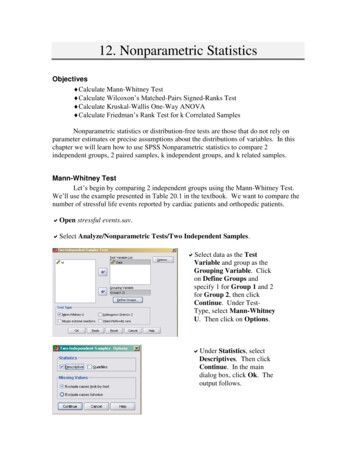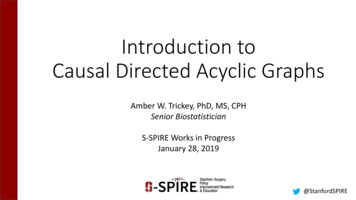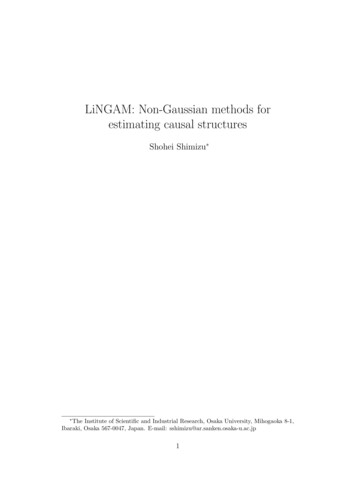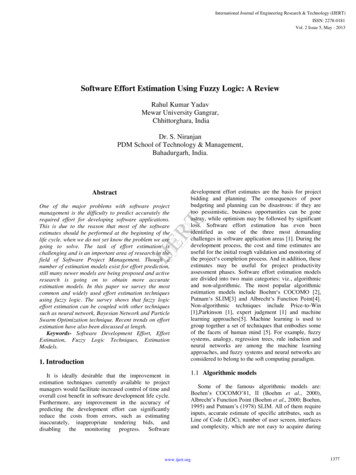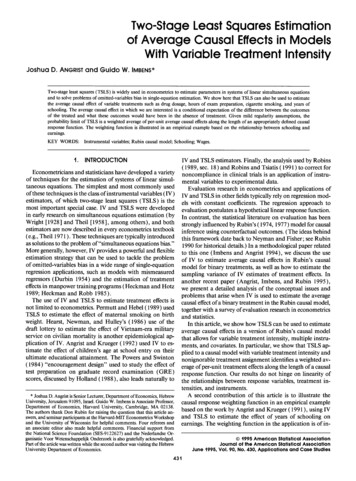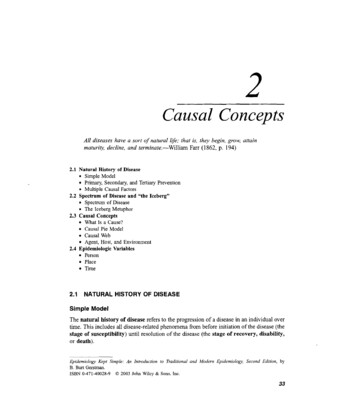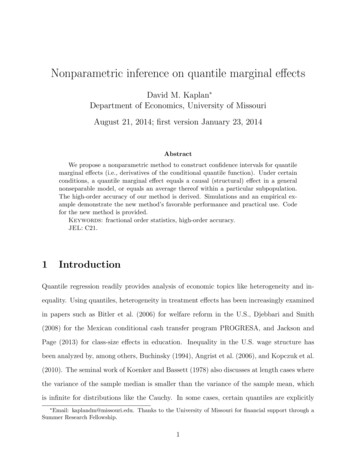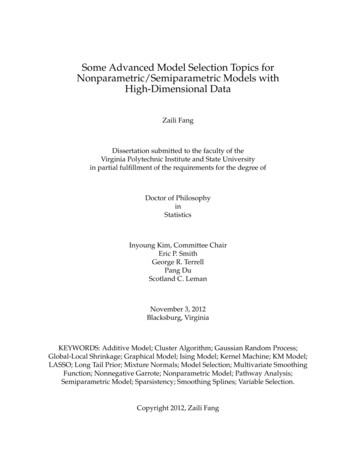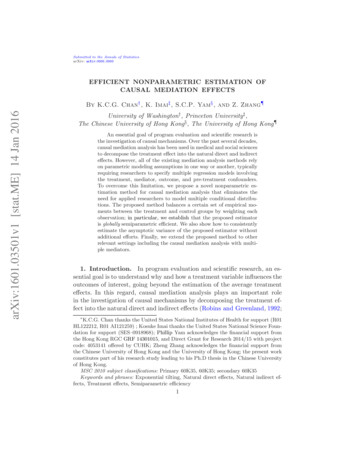
Transcription
Submitted to the Annals of StatisticsarXiv: arXiv:0000.0000EFFICIENT NONPARAMETRIC ESTIMATION OFCAUSAL MEDIATION EFFECTSarXiv:1601.03501v1 [stat.ME] 14 Jan 2016By K.C.G. Chan† , K. Imai‡ , S.C.P. Yam§ , and Z. Zhang¶University of Washington† , Princeton University‡ ,The Chinese University of Hong Kong§ , The University of Hong Kong¶An essential goal of program evaluation and scientific research isthe investigation of causal mechanisms. Over the past several decades,causal mediation analysis has been used in medical and social sciencesto decompose the treatment effect into the natural direct and indirecteffects. However, all of the existing mediation analysis methods relyon parametric modeling assumptions in one way or another, typicallyrequiring researchers to specify multiple regression models involvingthe treatment, mediator, outcome, and pre-treatment confounders.To overcome this limitation, we propose a novel nonparametric estimation method for causal mediation analysis that eliminates theneed for applied researchers to model multiple conditional distributions. The proposed method balances a certain set of empirical moments between the treatment and control groups by weighting eachobservation; in particular, we establish that the proposed estimatoris globally semiparametric efficient. We also show how to consistentlyestimate the asymptotic variance of the proposed estimator withoutadditional efforts. Finally, we extend the proposed method to otherrelevant settings including the causal mediation analysis with multiple mediators.1. Introduction. In program evaluation and scientific research, an essential goal is to understand why and how a treatment variable influences theoutcomes of interest, going beyond the estimation of the average treatmenteffects. In this regard, causal mediation analysis plays an important rolein the investigation of causal mechanisms by decomposing the treatment effect into the natural direct and indirect effects (Robins and Greenland, 1992; K.C.G. Chan thanks the United States National Institutes of Health for support (R01HL122212, R01 AI121259) ; Kosuke Imai thanks the United States National Science Foundation for support (SES–0918968); Phillip Yam acknowledges the financial support fromthe Hong Kong RGC GRF 14301015, and Direct Grant for Research 2014/15 with projectcode: 4053141 offered by CUHK; Zheng Zhang acknowledges the financial support fromthe Chinese University of Hong Kong and the University of Hong Kong; the present workconstitutes part of his research study leading to his Ph.D thesis in the Chinese Universityof Hong Kong.MSC 2010 subject classifications: Primary 60K35, 60K35; secondary 60K35Keywords and phrases: Exponential tilting, Natural direct effects, Natural indirect effects, Treatment effects, Semiparametric efficiency1
2K.C.G. CHAN, K. IMAI, S.C.P. YAM, AND Z. ZHANGPearl, 2001; Robins, 2003). Such an approach has been widely used in a number of disciplines in medical and social sciences (see e.g., Baron and Kenny,1986; Imai et al., 2011; MacKinnon, 2008; VanderWeele, 2015). The methodological literature on causal mediation analysis has also rapidly grown overthe last decade and produced numerous approaches and extensions (see, forexample, Albert, 2008; Geneletti, 2007; Imai, Keele and Yamamoto, 2010;Jo, 2008; Joffe et al., 2007; Sobel, 2008; Ten Have et al., 2007; Tchetgen Tchetgen and Shpitser,2012; VanderWeele, 2009; VanderWeele and Vansteelandt, 2010).In this article, we here contribute to this fast growing literature by developing a new efficient nonparametric estimation method for causal mediationanalysis. All of the existing mediation analysis methods rely on parametricmodeling assumptions in one way or another, typically requiring researchersto specify multiple regression models involving the treatment T , mediator M , outcome Y , and pre-treatment confounders X. For example, thestandard approach based on the so called “mediation formula” require thespecification of two or three conditional distributions, i.e. fY M,T,X , fM T,X ,and possibly fT X (for example, Imai, Keele and Tingley, 2010; Pearl, 2012;VanderWeele, 2009). Inference under this standard approach is only validwhen both the outcome model fY M,T,X and the mediator model fM T,X arecorrectly specified. Our proposed method eliminates the need for appliedresearchers to model these multiple conditional distributions a priori.We are inspired by the recent work of Tchetgen Tchetgen and Shpitser(2012) who develop a robust semiparametric estimation procedure to allowfor possible model misspecification. The authors show that their proposedestimator is consistent when any two out of three chosen models are correctlyspecified and is locally semiparametric efficient whenever all three modelsare correct. While this estimator represents an important advance in the literature, its validity still relies upon the correct specification of multiple parametric or semiparametric models. We improve this estimator by proposing aglobally semiparametric efficient estimator that attains the semiparametricefficiency bound, derived by Tchetgen Tchetgen and Shpitser (2012), without imposing the additional structural assumptions required for the existingsemiparametric estimator. To the best of our knowledge, no globally semiparametric efficient estimator has been proposed in the causal mediationliterature.Our proposed estimator is based on a strategy of balancing covariatesby weighting each observation, which has recently become popular when estimating the average treatment effects (for example, Chan, Yam and Zhang,2015; Hainmueller, 2012; Graham, Pinto and Egel, 2012; Imai and Ratkovic,2014). We combine this idea with the construction of globally semiparamet-
NONPARAMETRIC ESTIMATION OF CAUSAL MEDIATION EFFECTS3ric efficient estimation of the average treatment effects (see, Chen, Hong and Tarozzi,2008; Hahn, 1998; Hirano, Imbens and Ridder, 2003; Imbens, Newey and Ridder,2005). Unlike these plugin-type globally semiparametric efficient estimatorsthat require semi-parametric estimation of the propensity score or the outcome regression function, we adopt the nonparametric calibration approachdeveloped by Chan, Yam and Zhang (2015) that constructs observationspecific weights only from covariate balancing conditions. This is a significant advantage in causal mediation analysis because the plugin-type globallysemiparametric estimators would require the semi-parametric estimation ofthree conditional distributions, which is a difficult task in practice yieldingmore doubt on the robustness of the estimators.The rest of the paper is organized as follows. In Section 2, we describe theproposed estimation method, which matches the certain moment conditionsof the mediator and pre-treatment covariates between the treatment andcontrol groups. We then show how to consistently estimate the asymptoticvariance of the proposed estimator without additional functional estimation.In Section 3, we extend our method to the case of multiple mediators studied in Imai and Yamamoto (2013). We then discuss two related estimationproblems, namely the estimation of pure indirect effects and natural directeffect of the untreated. Finally, we apply the proposed methods to two datasets in Section 4 and offer concluding remarks in Section 5.2. The Proposed Methodology. In this section, we first consider theefficient nonparametric estimation of the average natural direct and indirect effects. In Theorem 1, we shall show that the proposed nonparametricestimator is consistent, asymptotically normal, and globally semiparametric efficient. We then demonstrate how to nonparametrically estimate theasymptotic variance of the proposed estimator.2.1. The framework. Suppose that we have a binary treatment variableT {0, 1}. Under the standard framework of causal inference, we let M (t)denote a potential mediating variable, which represents the value of the mediator if the treatment variable is equal to t {0, 1}. Similarly, let Y (t, m)represent the potential outcome variable under the scenario where the treatment and mediator variables take the value t and m, respectively. Then, theobserved mediator M is given by M T M (1) (1 T )M (0) whereas theobserved outcome is equal to Y T Y (1, M (1)) (1 T )Y (0, M (0)). Weassume that we have a simple random sample of size N from a population and therefore observe the i.i.d. realizations of these random variables,{Ti , Mi , Yi , Xi }Ni 1 where X is a vector of pretreatment covariates.
4K.C.G. CHAN, K. IMAI, S.C.P. YAM, AND Z. ZHANGA primary goal of causal mediation analysis is the following decomposition of the average treatment effect into the average natural indirect effect(or average causal mediation effect) and the average natural direct effect(Robins and Greenland, 1992; Pearl, 2001; Robins, 2003)(2.1)E[Y (1, M (1)) Y (0, M (0))] E[Y (1, M (1)) Y (1, M (0))] E[Y (1, M (0)) Y (0, M (0))]The average natural indirect effect, which is the first term in this equation, isthe average difference between the potential outcome under the treatmentcondition and the counterfactual outcome under the treatment conditionwhere the mediator is equal to the value that would have realized under thecontrol condition. This quantity represents the average difference that wouldresult if the mediator value changes from M (0) to M (1) while holding thetreatment variable constant at T 1. In contrast, the average natural directeffect, which is the second term in equation (2.1), represents the averagetreatment effect when the mediator is held constant at M (0). Therefore,this decomposition enables researchers to explore how much of the treatmenteffect is due to the change in the mediator.Note that the following alternative decomposition for causal mediationanalysis is also possible,(2.2)E[Y (1, M (1)) Y (0, M (0))] E[Y (0, M (1)) Y (0, M (0))] E[Y (1, M (1)) Y (0, M (1))]where the treatment variable is held constant at T 0 for the natural indirect effect and the mediator is fixed at M (1) for the natural direct effect.Robins (2003) called this version of the natural indirect effect as the pure indirect effect while referring the natural indirect effect given in equation (2.1)as the total indirect effect since it is resulted from both treatment and mediator. Our proposed estimator is applicable to both cases as the differencebetween the two decompositions solely depends on the value at which thetreatment is fixed.To nonparametrically identify the average natural direct and indirect effects, we rely on the following set of assumptions as in Imai, Keele and Tingley(2010) and Tchetgen Tchetgen and Shpitser (2012).Assumption 1.1. (Consistency) If T t, then M M (t) with probability 1 for t {0, 1}. If T t and M m, then Y Y (t, m) with probability 1 fort {0, 1} and m M, where M is the support of the distribution ofM.
NONPARAMETRIC ESTIMATION OF CAUSAL MEDIATION EFFECTS52. (Sequential Ignorability) Given X, {Y (t′ , m), M (t)} is independent ofT for t, t′ {0, 1}. Also, given T t and X, Y (t′ , m) is independentof M (t) for t, t′ {0, 1} and m M.3. (Positivity) With probability 1 with respect to any (t, x) where t {0, 1} and x X , fM T,X (m t, x) 0 for all m M where Xis the support of X. With probability 1 with respect to any x X ,fT X (t x) 0 for all t {0, 1}.The sequential ignorability assumption is a natural extension of the unconfoundedness assumption for the identification of the average treatment effect except that it requires the “cross-world” independence between Y (t′ , m)and M (t) (see, Richardson and Robins, 2013). Several researchers have proposed different sensitivity analysis techniques for estimating the bias thatarises when this assumption is violated (see, Imai, Keele and Yamamoto,2010; VanderWeele, 2010; Tchetgen Tchetgen and Shpitser, 2012). UnderAssumption 1, Imai, Keele and Yamamoto (2010) showed that the averagenatural direct and indirect effects are nonparametrically identified. That is,θt E(Y (1 t, M (t)))Z Z E(Y T 1 t, M m, X x)fM T,X (m T t, X x)fX (x)dxdmandδt E(Y (t, M (t))) ZE(Y T t, X x)fX (x)dxfor t 0, 1.Tchetgen Tchetgen and Shpitser (2012) made an important theoreticaladvance by showing that under Assumption 1 the efficient influence functionof θt is given by,S θt 1{T 1 t}fM T,X (M T t, X){Y E(Y X, M, T 1 t)}fT X (1 t X)fM T,X (M T 1 t, X)1{T t} {E(Y X, M, T 1 t) η(1 t, t, X)} η(1 t, t, X) θtfT X (t X)(2.3)where′η(t, t , X) ZE(Y X, M m, T t)fM T,X (m T t′ , X)dm
6K.C.G. CHAN, K. IMAI, S.C.P. YAM, AND Z. ZHANGfor t, t′ {0, 1}. Hence, the definition of η implies that η(1, 1, X) E(Y X, T 1) and η(0, 0, X) E(Y X, T 0).Furthermore, the efficient influence functions of the average natural direct effect when t 0, i.e., NDE θ0 δ0 , and the average natural indirecteffect when t 1 (or the average total indirect effect), i.e., NIE δ1 θ0 ,are SNDE Sθ0 Sδ0 and SNIE Sδ1 Sθ0 , respectively, where Sδ1 and Sδ0are the efficient influence functions for estimating δ1 and δ0 . As shown inRobins, Rotnitzky and Zhao (1994) and Hahn (1998), these efficient influence functions are given by,(2.4)Sδt 1{T t}{Y E(Y X, T t)} E(Y X, T t) δt ,fT X (t X)for t 0, 1. Similarly, the average natural indirect effect when t 0 (or thepure indirect effect) is given by PIE θ1 δ0 and its efficient function isequal to Sθ1 Sδ0 . Therefore, the efficient estimations of the natural directand indirect effects involve the efficient estimation of δt and θt for t 0, 1.2.2. Efficient estimation of δ1 and δ0 . Before proposing a globally semiparametric efficient estimator of θ0 , which is one of the main contributions ofour paper, we discuss the efficient estimation of δ1 and δ0 , which is requiredfor the efficient estimation of the natural direct and indirect effects. There exists an extensive literature on the globally efficient estimation of δ0 and δ1 ineconometrics (see, for example, Chen, Hong and Tarozzi, 2008; Hahn, 1998;Hirano, Imbens and Ridder, 2003; Imbens, Newey and Ridder, 2005). However, many of these existing estimators require the semi-parametric estimation of propensity score or outcome regression model. In this paper, we focuson a globally efficient estimator recently proposed by Chan, Yam and Zhang(2015), which serves as a building block of our proposed estimator of θ0 discussed below. Unlike the other estimators, this approach achieves the efficient nonparametric estimation by balancing covariates through weighting.Let p0 (x) , N1 fT X (1 x) 1 and q0 (x) , N1 fT X (0 x) 1 . Under Assumption 1, for any suitable integrable functions u(x), the following importantmoment conditions hold,!NX(2.5)δ1 ETi p0 (Xi )Yi(2.6)δ0 Ei 1NXi 1(1 Ti )q0 (Xi )Yi!
NONPARAMETRIC ESTIMATION OF CAUSAL MEDIATION EFFECTSNXE(u(X)) E(2.7)Ti p0 (Xi )u(Xi )i 1NXE(u(X)) E(2.8)i 1!7!(1 Ti )q0 (Xi )u(Xi )The first two equalities represent the inverse-probability-weighting (IPW)estimators of the average potential outcomes. A number of scholars haveexploited the covariate balance conditions in equations (2.7) and (2.8) in order to estimate the average treatment effects (e.g., Chan and Yam, 2014;Han and Wang, 2013; Imai and Ratkovic, 2014; Graham, Pinto and Egel,2012; Qin and Zhang, 2007). These existing estimators are locally semiparametric efficient, yet all of these rely on parametric models in one way oranother.Our goal is, however, to develop a globally fully nonparametric efficient estimator. Thus, we utilize the nonparametric estimator proposed by Chan, Yam and Zhang(2015). Let D(v, v ′ ) be a distance measure for v, v ′ R. That is, we assume that D(v, v ′ ) is continuously differentiable in v R, non-negative, andstrictly convex in v with D(v, v) 0. Based on equations (2.7) and (2.8),Chan, Yam and Zhang (2015) constructs calibration weights by solving thefollowing minimization problem subject to constraints that are empiricalcounterparts of equations (2.7) and (2.8):MinimizeNXTi D(N pi , 1)i 1(2.9)subject toNXTi pi uK (Xi ) i 1N1 XuK (Xi ),Ni 1andMinimizeNXi 1(2.10)(1 Ti )D(N qi , 1)subject toNXi 1(1 Ti )qi uK (Xi ) N1 XuK (Xi ),Ni 1where uK is a K(N )-dimensional function of X, whose components forma set of orthonormal polynomials, here K(N ) increases to infinity when Ngoes to infinity yet with K(N ) o(N ). Furthermore, note that all theseuK ’s have to form a basis on L as K goes to infinity.
8K.C.G. CHAN, K. IMAI, S.C.P. YAM, AND Z. ZHANGFurthermore, to gain computational efficiency for implementation, theyconsider the dual problems of equations (2.9) and (2.10). While the primalproblems given in equations (2.9) and (2.10) are convex separable programming with linear constraints, Tseng and Bertsekas (1987) showed that thedual problems are unconstrained convex maximization problems, which canbe solved by efficient and stable numerical algorithms. With slight abuse ofnotation, denote D(v) D(v, 1). For observations with Ti 1, the dualsolution is given by,p̂K (Xi ) ,(2.11) 1 ′ Tρ φ̂K uK (Xi ) ,Nwhere ρ′ is the first derivative of the following strictly concave function, (2.12)ρ(v) D (D ′ ) 1 ( v) v · (D ′ ) 1 ( v),and φ̂K RK maximizes the following objective function,(2.13)N o1 XnF̂K (φ) ,Ti ρ φ uK (Xi ) φ uK (Xi ) .Ni 1Similarly, for observations with Ti 0, 1 ′ T(2.14)ρ λ̂K uK (Xi ) ,q̂K (Xi ) ,Nwhere λ̂K RK maximizes the following objective function,(2.15)NX bK (λ) , 1G(1 Ti )ρ λT uK (Xi ) λT uK (Xi )N.i 1According to the first order conditions for the maximizations given inequations (2.13) and (2.15), one can easily verify that the linear constraintsin equations (2.9) and (2.10) are satisfied. Finally, Chan, Yam and Zhang(2015) proposed the following empirical covariate balancing estimator for δ1and δ0 ,(2.16)δ̂1K ,NXi 1Ti p̂K (Xi )Yiandδ̂0K ,NXi 1(1 Ti )q̂K (Xi )YiThe authors showed that δ̂1K and δ̂0K attain the semiparametric efficiencybounds given in equation (2.4) under mild regularity conditions.
NONPARAMETRIC ESTIMATION OF CAUSAL MEDIATION EFFECTS92.3. Efficient estimation of θ0 and θ1 . We begin by considering the efficient estimation of θ0 . As explained below, the same approach can be applied to efficiently estimate θ1 . The efficient influence function of θ0 given inequation (2.3), involves three sets of nonparametric functions: fT X (1 X),fM T,X (M T t, X) for t 0, 1, and E(Y X, M, T 1). While it ispossible to construct a globally efficient estimator of θ0 by plugging the corresponding nonparametric estimates into equation (2.3), the performance ofthe resulting estimator may be poor because it is difficult to estimate theconditional density of a possibly continuous mediator and fM T,X (M 1, X)appears in the denominator of the first term of Sθ0 . The direct nonparametricestimation of fM T,X usually results in extreme weights and the corresponding weighting estimator can become unstable.Our goal is to construct a weighting estimator for θ0 . Let us represent θ0as a weighted average of Y among the treated, fM T,X (M 0, X)TY·(2.17).θ0 EfT X (1 X) fM T,X (M 1, X)Furthermore, define,(2.18)r0 (m, x) ,fM T,X (m 0, x).N fT X (1 x)fM T,X (m 1, x)Ifr0 (m, x) is a known function, then a natural estimator for θ0 is θ̃0 PNi 1 Ti r0 (Mi , Xi )Yi , which converges to θ0 by the Law of Large Number.Since r0 (m, x) is mostly unknown, we shall replace it by an estimated weight.To construct moment conditions for estimating r0 (m, x), we need to developa covariate balancing property extending equations (2.7) and (2.8). Thisresult is given in the following lemma.Lemma 1. With q0 (x) (N fT X (0 x)) 1 and r0 (x, m) defined in equation (2.18), we haveE[T r0 (X, M )v(X, M )] E[(1 T )q0 (X)v(X, M )]for any suitable integrable functions v.Proof.E[T r0 (X, M )v(X, M )] E[r0 (X, M )v(X, M )fT X,M (1 X, M )] fM T,X (M 0, X)1v(X, M )fT X,M (1 X, M ) EN fT X (1 X) fM T,X (M 1, X)
10 K.C.G. CHAN, K. IMAI, S.C.P. YAM, AND Z. ZHANGZZfM T,X (m 0, x)1v(x, m)fT X,M (1 x, m)fX,M (x, m)dxdmM X N fT X (1 x) fM T,X (m 1, x)Z ZfM T,X (m 0, x)1v(x, m)fT,X,M (1, x, m)dxdmM X N fT X (1 x) fM T,X (m 1, x)Z ZfM T,X (m 0, x)v(x, m)fT,M X (1, m x)fX (x)dxdmM X N fM,T X (m, 1 x)Z Z1f(m 0, x)v(x, m)fX (x)dxdmN M X M T,XZ Zv(x, m)fT X,M (0 x, m)fX,M (x, m)dxdmM X N fT X (0 x) E[q0 (X)v(X, M )fT X,M (0 X, M )] E[(1 T )q0 (X)v(X, M )].Lemma 1 motivates us to consider the empirical covariate balancing weightsr̂K (x, m) which solves for the following constrained optimization problem:(2.19)MinimizeNXTi D(N ri , 1)subject toi 1NXi 1Ti ri vK (Xi , Mi ) NX(1 Ti )q̂K (Xi )vK (Xi , Mi ) .i 1Note that q̂K (x) is constructed from equations (2.14) and (2.15), and vK (x, m)with K N is a L-dimensional vector-valued function, whose componentsform a set of orthonormal polynomials, where L O(K), i.e. L is of thesame order as K. Furthermore, note that these vK ’s have to form a basis onL as K goes to infinity.The weights r̂K (x, m)′ s are obtained by minimizing the aggregate distancebetween the final weights to a vector of constant working design weights, subject to an empirical analogue of the moment conditions given in Lemma 1.Unlike to the case of Deville and Särndal (1992) who used the true andknown design weights commonly available in sample surveys, the true design weights for our problem r0 (m, x) is unknown and is a function of twounknowns fT X (1 X) and fM T,X (M T, X). Therefore, calibration of truedesign weights is impossible in this case. While the true weights are unavailable, we choose the uniform working design weights because they make itless likely to yield extreme weights. Even with misspecified design weights,
NONPARAMETRIC ESTIMATION OF CAUSAL MEDIATION EFFECTS11however, we can still show that the proposed weighting estimator is globallysemiparametric efficient.Similar to equations (2.11) and (2.14), we can derive the dual solution forequation (2.19). For observations in the treatment group, i.e., Ti 1, 1 ′ (2.20)ρ β̂K vK (Xi , Mi ) ,r̂K (Xi , Mi ) ,Nwhere ρ′ is the first derivative of the function given in equation (2.12), andβ̂K maximizes the following objective function:(2.21)N n oXb K (β) , 1HTi ρ β vK (Xi , Mi ) N (1 Ti )q̂K (Xi )β vK (Xi , Mi ) .Ni 1b K , we can check thatFrom the first order condition of the maximization of H(2.22)NN X1 X ′bTi ρ β̂K vK (Xi , Mi ) vK (Xi , Mi ) (1 Ti )q̂K (Xi )vK (Xi , Mi ) 0.HK (β̂K ) Ni 1i 1Now, we define the proposed estimator for θ0 to be(2.23)θ̂0K,NXTi r̂K (Xi , Mi )Yi .i 1Asymptotic properties of θ̂0K will be derived in the next subsection. We shallshow that θ̂0K is globally semiparametric efficient under some mild regularityconditions. Therefore, the proposed estimators δ̂1K θ̂0K and θ̂0K δ̂0K areglobally semiparametric efficient estimators for the average natural indirectand direct effects respectively.The relationship given in equation (2.12) between ρ(v) and D(v) is derivedin the supplementary materials. In the supplementary materials, we alsoshow that the strict convexity of D is equivalent to the strict concavityof ρ. Since the dual formulation is equivalent to the primal problem, weshall express the proposed estimator in terms of ρ(v) in the rest of thepresent paper. When ρ(v) exp( v), the weights are equivalent to theimplied weights of exponential tilting (Kitamura and Stutzer, 1997). Whenρ(v) log(1 v), the weights correspond to empirical likelihood (Qin andLawless, 1994). When ρ(v) (1 v)2 /2, the weights are the implied weightsof the continuous updating estimator of the generalized method of moments(Hansen, Heaton and Yaron, 1996).
12K.C.G. CHAN, K. IMAI, S.C.P. YAM, AND Z. ZHANGThe proposed estimator θ̂0K is constructed in a similar manner as donefor δ̂1K and δ̂0K (see Section 2.2). However, there are some important differences. First, δ̂1K and δ̂0K only require balancing pre-treatment variablesX, but θ̂0K requires balancing both pre-treatment variables X and posttreatment mediators M . Moreover, in equation (2.21), ρ appears explicitlyin the first term and implicitly in the second term through the dependencyof q̂K (x) on ρ. This creates new challenges to the establishment of theoretical results. Note that although we consider the weights estimated through aspecific ρ(v), the functional form of the true weights r0 (x, m) is unspecified.It will be shown later that any function r0 (x, m), satisfying a mild differentiability assumption, can be approximated arbitrarily well by r̂K (x, m)uniformly as the sample size increases, so long as ρ(v) also satisfies a mildregularity condition.We can apply the same methodology to the estimation of θ1 . Note that fM T,X (M 1, X)(1 T )Y·(2.24)θ1 EfT X (1 X) fM T,X (M 0, X)Definew0 (x, m) ,fM T,X (m 1, x)N fT,M X (0, m x)For any suitable integrable v(x, m), we have fM T,X (M 1, X)v(X, M )E (1 T )fT,M X (0, M X)Z ZfM T,X (m 1, x) v(x, m)fT,M,X (0, m, x)dxdmM X fT,M X (0, m x)Z ZfM,T,X (m, 1, x) v(x, m)fX (x)dxdmfT,X (1, x)M X T v(X, M ) E.fT X (1 X)Therefore, we can construct empirical covariate balancing weights ŵK fromthe following constrained maximization problem:MinimizeNX(1 Ti )D (N wi , 1) subject toi 1NNXXTi p̂K (Xi )vK (Xi , Mi ) .(1 Ti )wi vK (Xi , Mi ) i 1i 1
NONPARAMETRIC ESTIMATION OF CAUSAL MEDIATION EFFECTS13Its dual solution is given by, 1 ′ ρ γ̂K vk (x, m) ,ŵK (x, m) ,Nwhere γ̂K maximizes the following objective function,Ni1 Xh(1 Ti )ρ(γ vK (Xi , Mi )) N Ti p̂K (Xi )γ vK (Xi , Mi )JˆK (β) ,Ni 1Then, we can now suggest the estimator of PIE θ1 δ0 by:(2.25)d , θ̂1K δ̂0K PIENNXX(1 Ti )q̂K (Xi )Yi .(1 Ti )ŵK (Xi , Mi )Yi i 1i 12.4. Asymptotic properties. To derive the asymptotic properties of theproposed estimator, we list all additional technical assumptions that arerequired beyond Assumption 1.Assumption 2.E(Y 2 T 0) and E(Y 2 T 1) .Assumption 3.1. The support X of r1 -dimensional covariate X is a Cartesian productof r1 compact intervals.2. The support M of r2 -dimensional mediating variable M is a Cartesianproduct of r2 compact intervals.Denote r , r1 r2 .Assumption 4. There exist some constants η1 , η2 , η3 , η4 , η5 , η6 such thatthe following inequalities hold:11 fT X (0 x) 1,η1η211 fM T,X (m 0, x) 1,0 η3η411 fM T,X (m 1, x) 1.0 η5η60 Assumption 5. The functions, q(x) and r(x, m), are s-times and s′ times continuously differentiable, respectively, where s′ 19r 0 and s 16r1 0.
14K.C.G. CHAN, K. IMAI, S.C.P. YAM, AND Z. ZHANGAssumption 6. The function E(Y T 1, M m, X x) is t-timesjointly continuously differentiable with respect to (x, m), and η(1, 0, x) is d′ times continuously differentiable w.r.t. x, where d 3r/2 and d′ 3r1 /2. 111ν. ν 17Assumption 7. K O(N ) and s′ /r 2 s/r1 1Assumption 8. ρ C 3 (R) is a strictly concave function defined on Ri.e., ρ′′ (γ) 0, γ R, and the range of ρ′ contains the following subset ofthe positive real line: η1η2η2 η5η1 η6[η2 , η1 ] ,,. η1 1 η2 1(η1 1) η3 (η2 1) η4Assumptions 1–7 or similar assumptions also appeared in the literature(e.g., Chan, Yam and Zhang, 2015; Hahn, 1998; Hirano, Imbens and Ridder,2003; Imbens, Newey and Ridder, 2005). As explained earlier, Assumption 1is used for the identification of the natural direct and indirect effects. Assumption 2 is required for the finiteness of asymptotic variance. Assumptions 3 and 4 are needed to establish the uniform boundedness of approximations. Assumptions 5 and 6 are required for controlling the remainderof approximations with a given set of basis functions. Assumption 8 is required for controlling the stochastic order of the reminder terms, which issatisfied by commonly used ρ functions as discussed above. This final assumption imposes a mild regularity condition on ρ. Chan, Yam and Zhang(2015) maintains the same assumption.Two intermediate lemmas are needed to prove the main theorem. Wedefine the following intermediate quantities that are probability limits ofbK , λ̂K , q̂K , Hb k , β̂K and r̂K for each fixed K:FbK , φ̂K , p̂K , Gh i FK(φ) , E T ρ φ uK (X) φ uK (X) E FbK (φ) ,φ K (φ) ,, arg max FKφ RK 1 ′ ρ (φK ) uK (x) ,Nh i bK (λ) ,GK (λ) , E (1 T )ρ λ uK (X) λ uK (X) E Gp K (x) ,λ K, arg max G K (λ) , qK(x) ,λ RK 1 ′ ρ (λK ) uK (x) ,N
NONPARAMETRIC ESTIMATION OF CAUSAL MEDIATION EFFECTS15h i HK(β) , E T ρ β vK (X, M ) (1 T )(fT X (0 X)) 1 β vK (X, M ) , βK (β) ,, arg max HKβ RK rK(x, m) , 1 ′ ρ (βK ) vK (x, m) .NAlso, let ζ(K) supx X uK (x) . The following lemma establishes the (x) and r (x, m).approximation of functions p0 (x), q0 (x), r0 (x, m) by p K (x), qKKLemma 2.Under Assumptions 3, 4, 5, and 7, we have, ssup N p0 (x) N p K (x) O K 2r1 ζ(K) ,x X s sup N q0 (x) N qK(x) O K 2r1 ζ(K) ,x Xsup(x,m) X M s′ N r0 (x, m) N rK(x, m) O K 2r ζ(K) .Proof. The proof is given in the supplementary material.The other lemma is about the performance of the estimated auxiliary parameters, φ̂K , λ̂K , and β̂K that maximize equations (2.13), (2.15), and (2.21)respectively.Lemma 3.Under Assumptions 3, 4, 5, and 7, we haver !K,kφ̂K φ K k OpNr !Kkλ̂K λ K k Op,N!r5K kβ̂K βKk Op.NProof. The proof is given in the supplementary material.The following theorem shows that θ̂0K is consistent, asymptotically normal, and globally semiparametric efficient.Theorem 1.Under Assumptions 1–8, θ̂0K has the following properties:
16K.C.G. CHAN, K. IMAI, S.C.P. YAM, AND Z. ZHANG1. θ̂0K NXi 1 2. NNXi 1pTi r̂K (Xi , Mi )Yi θ0 ;Ti r̂K (Xi , Mi )Yi θ0! d N (0, Vθ0 ), where Vθ0 E Sθ20 ,attains the semi-pa
arXiv:1601.03501v1 [stat.ME] 14 Jan 2016 Submitted to the Annals of Statistics arXiv: arXiv:0000.0000 . K.C.G. Chan thanks the United States National Institutes of Health for support (R01 HL122212, R01 AI121259) ; Kosuke Imai thanks the United States National Science Foun- . We combine this idea with the construction of globally semiparamet-

